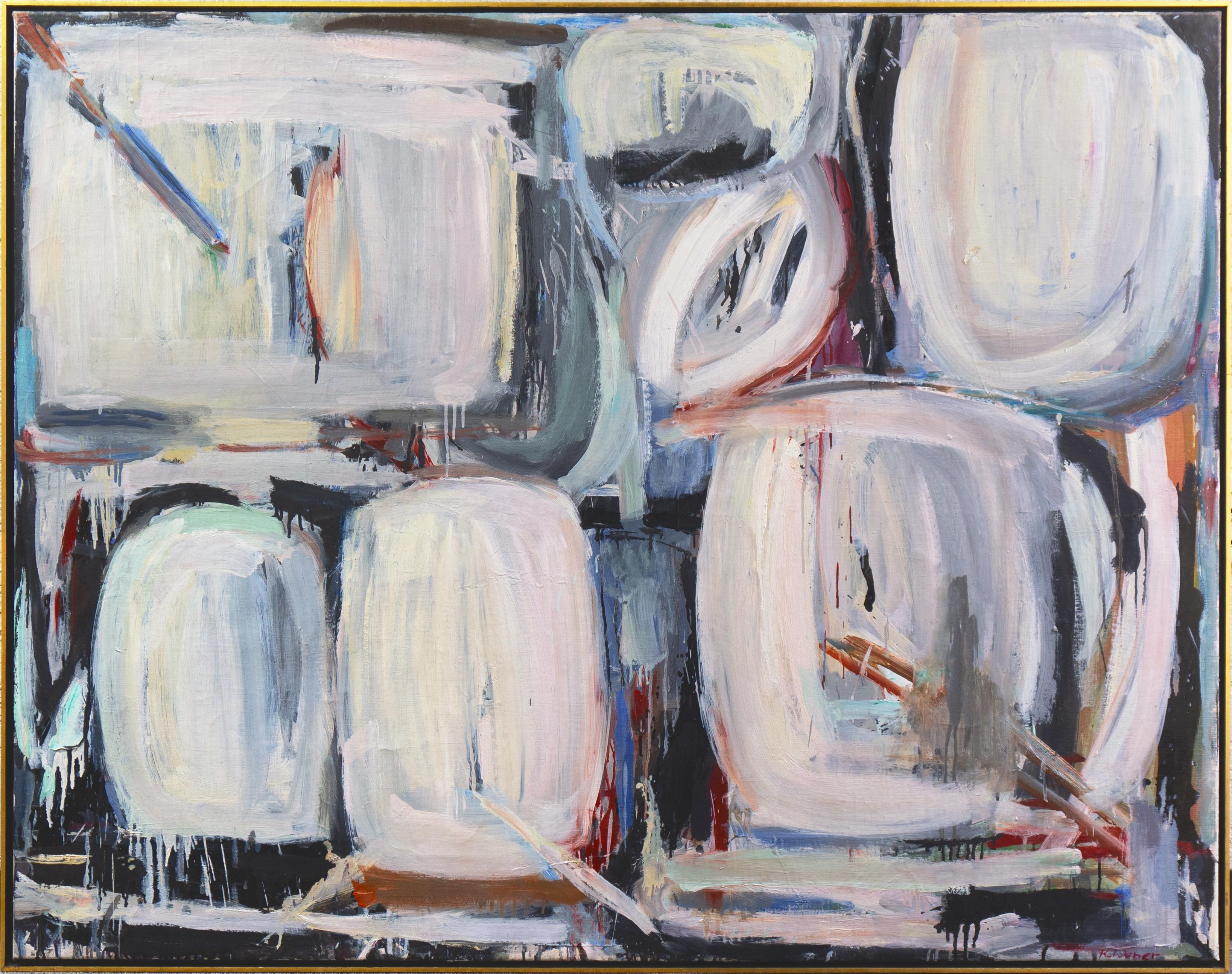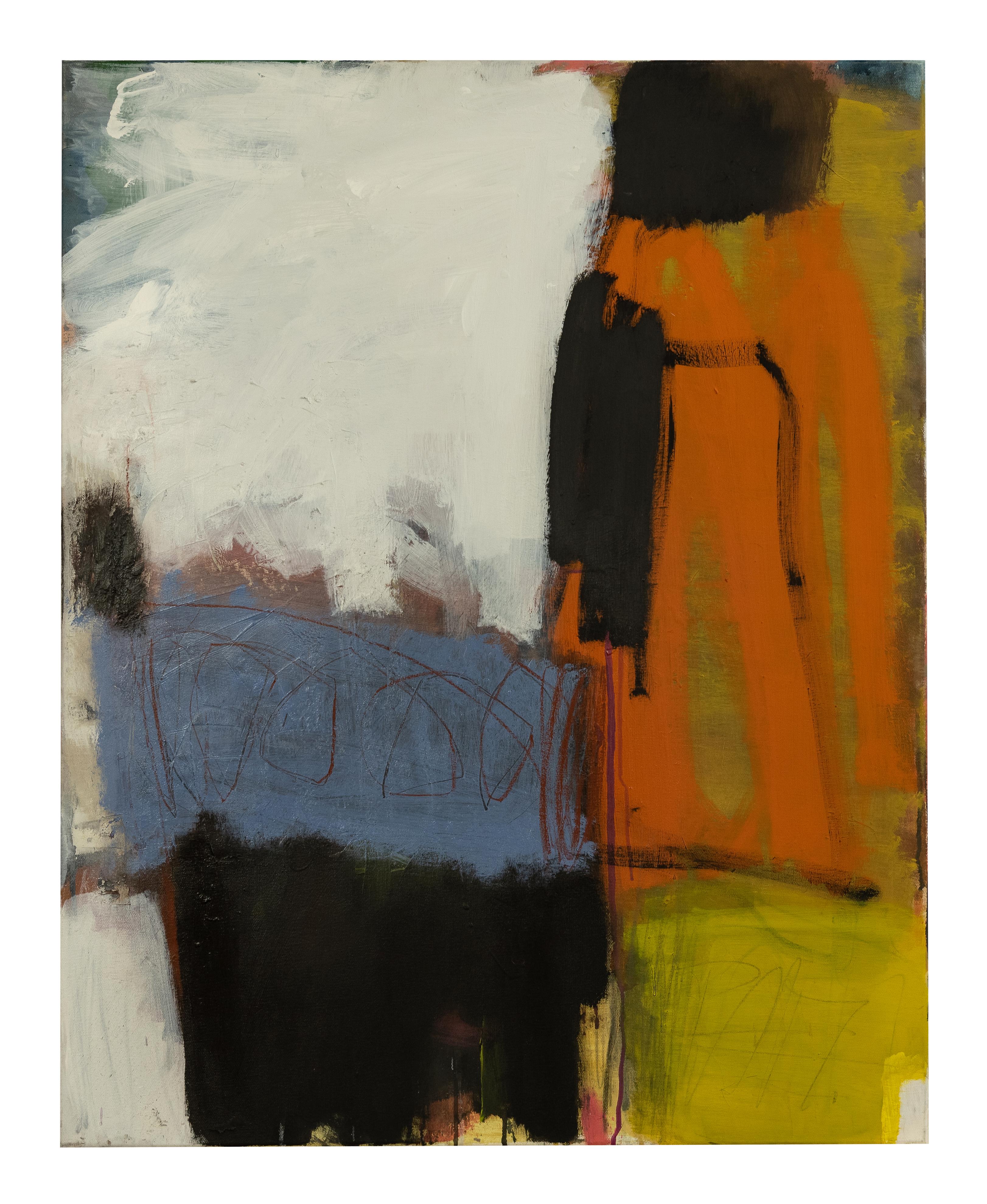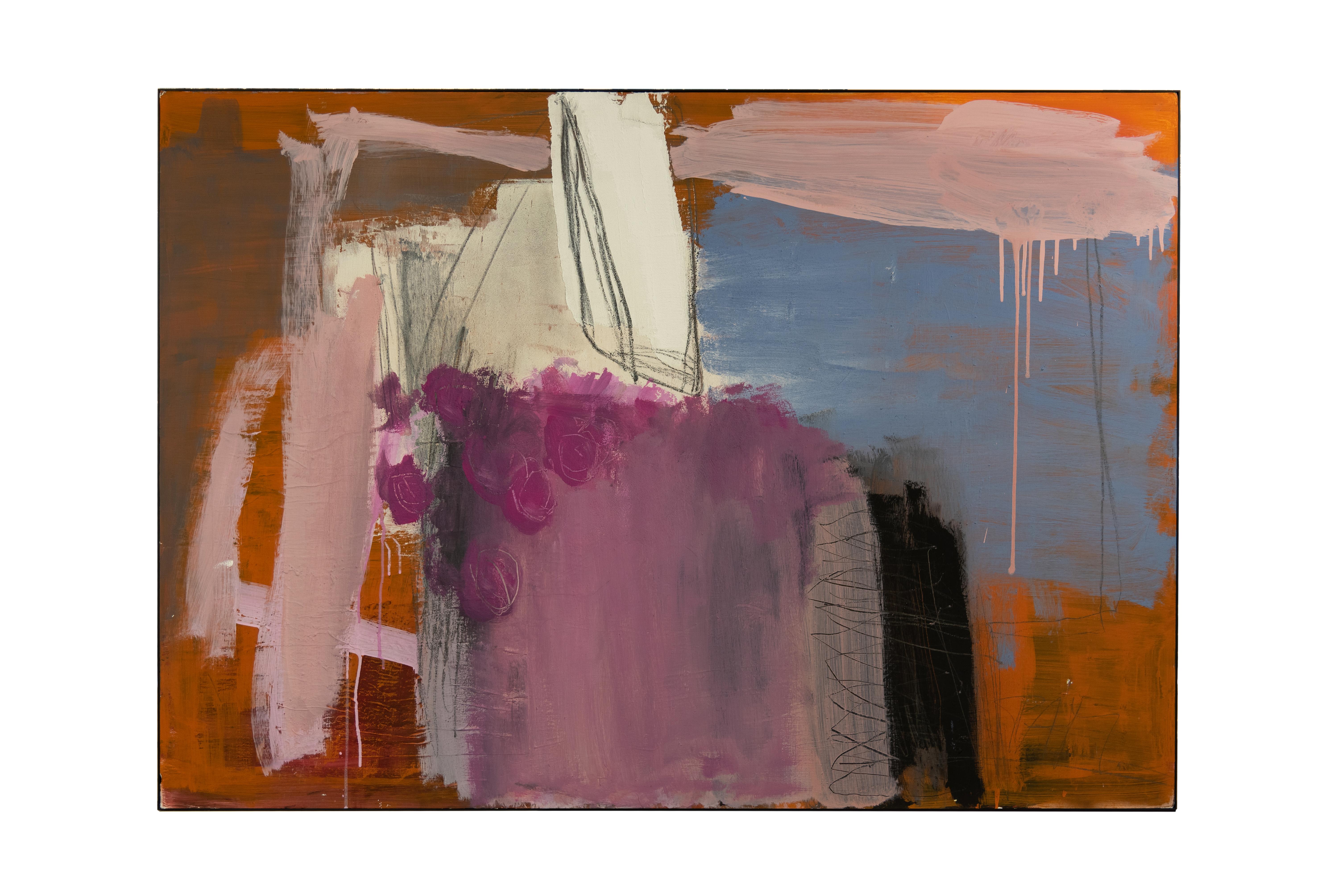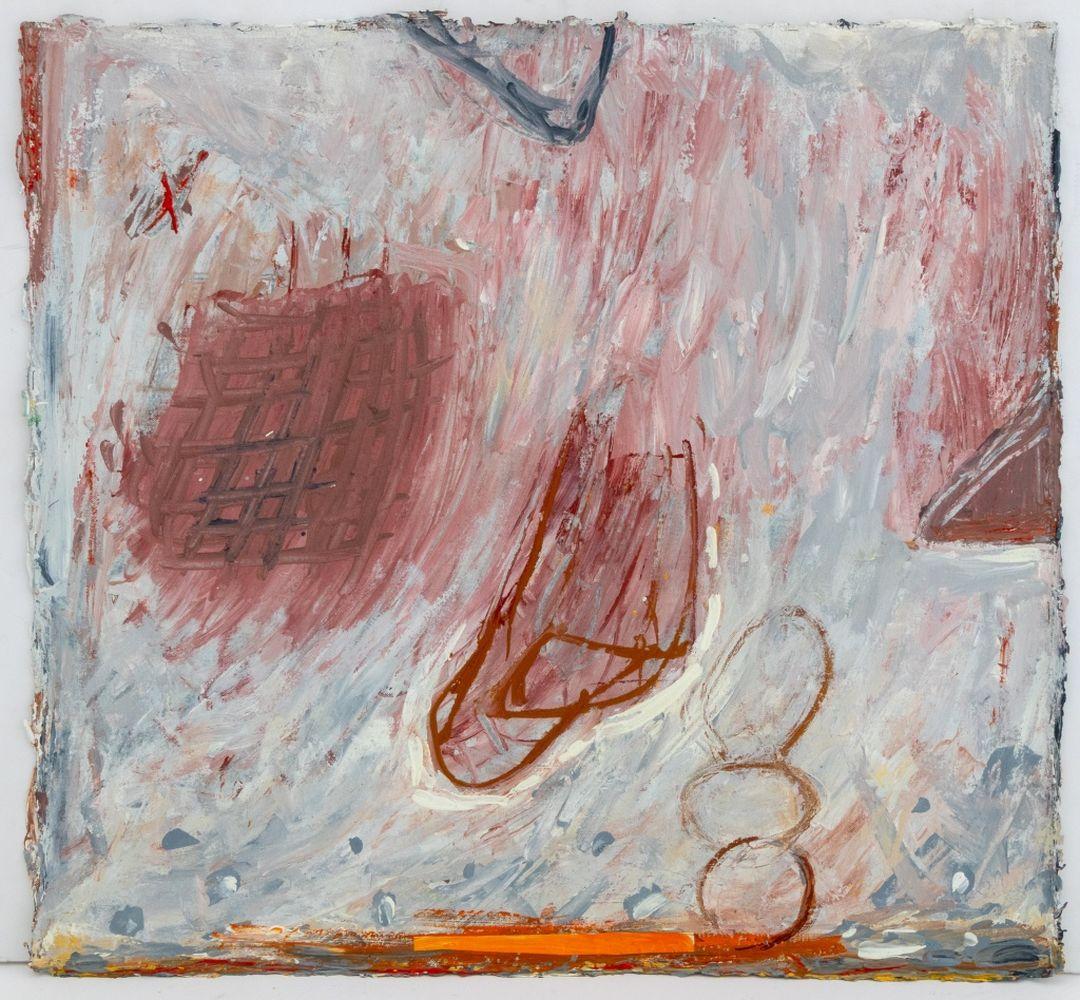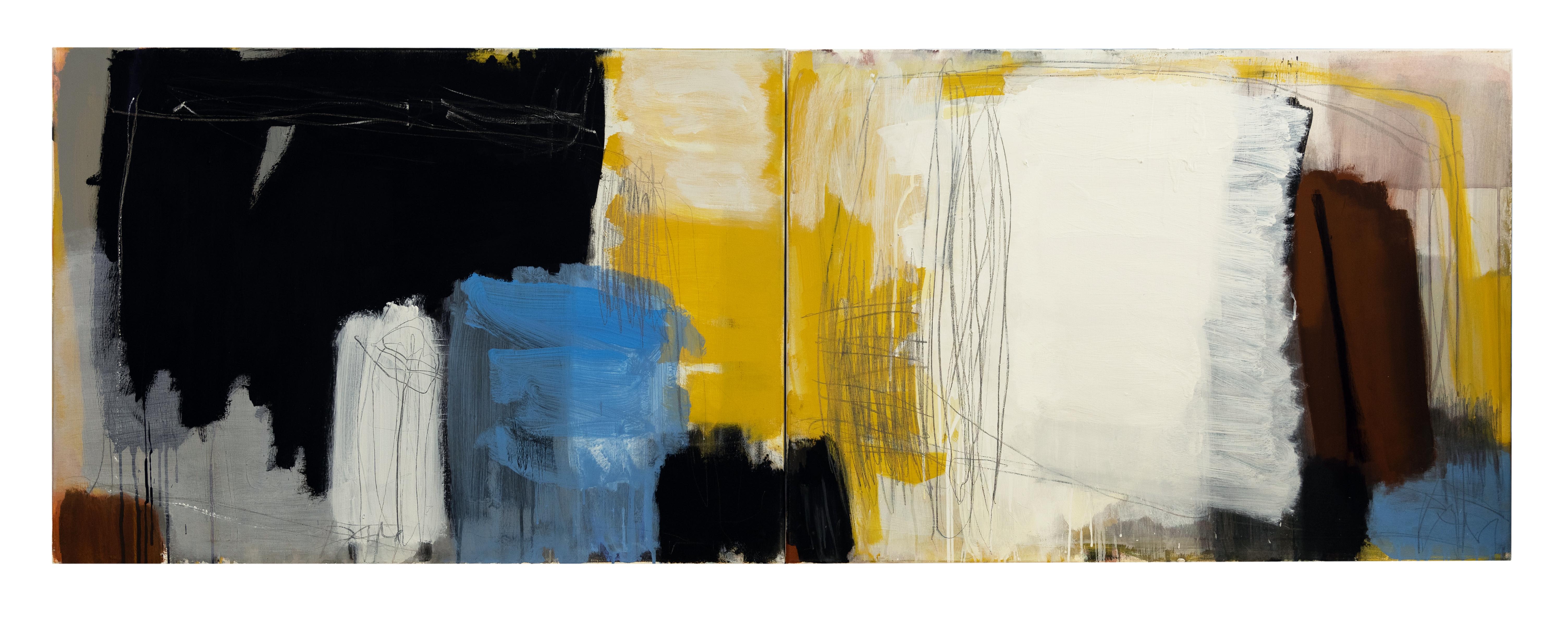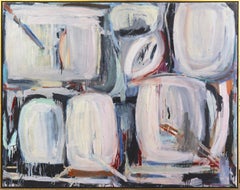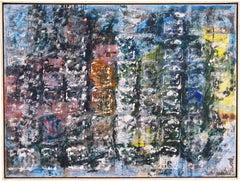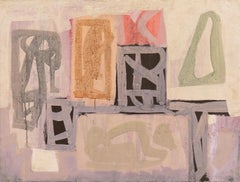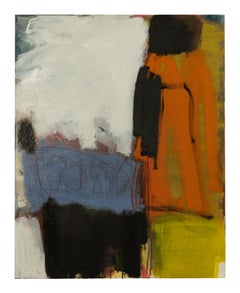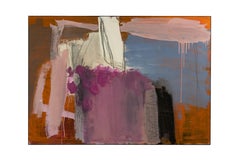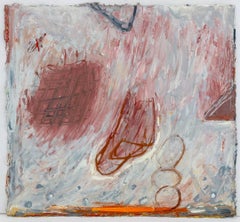Items Similar to 'Abstract, Parchment and Rose', Musée d'Art Moderne, Paris
Want more images or videos?
Request additional images or videos from the seller
1 of 17
Kurt Weber'Abstract, Parchment and Rose', Musée d'Art Moderne, Paris1963
1963
$8,500
£6,527.63
€7,480.59
CA$11,965.90
A$13,404.45
CHF 6,984.94
MX$163,506.66
NOK 88,762.59
SEK 83,696.80
DKK 55,833.07
About the Item
Signed lower right, 'Kurt Weber' for Kurt Oscar Weber (Swiss-American, 1938-2011); additionally dated, verso, May 1963, and signed.
Framed dimensions: 46 H x 1.5 D x 58.5 W inches.
A substantial oil showing circular forms in cream and rose contrasted against a variegated ink blue ground. Artist and sculptor Kurt Oscar Weber worked in multiple styles including German Expressionism, Abstract Expressionism and Color Field, developing a personal style that combined lyrical abstracts and soft color palette.
Born in Zurich, Kurt Oscar Weber first attended Zurich's Kunstgewerbeschule (1955-58) before moving to Paris, where he furthered his education at the Académie d’Art in Montparnasse with André Lhôte (1959). Here, he studied both sculpture and painting with Lhôte who became a significant influence on Weber’s emerging talent.
Weber subsequently traveled to Italy where he studied the fresco techniques of the Renaissance masters including Andrea Mantegna, Caravaggio, Pierro Della Francesca, and Fra Angelica. Following this period in Italy, Weber moved to Salzburg, where he studied with Oskar Kokoschka, and to Zurich, where he attended the École des Beaux-Arts, before returning to Paris where he continued his studies at the Académie de la Peinture et de Sculpture.
As Weber's interest in print media developed, he also studied lithography and etching (1963) at Atelier 17 with the American graphic artist, Stanley Hayter. The art historian, Andrin Schütz, observed that Weber's conscious integration of his knowledge of eclectic art styles and techniques into the practical application of his own art creation.
The burgeoning cultural and counter-cultural atmosphere of Paris during the early 1960s also had a strong influence on Weber as he was drawn into the growing environment of Existentialism. It was at this time that Weber met Jean-Paul Sartre, Pablo Picasso and Fernand Léger. However, the greatest influence on his art-philosophical outlook was his compatriot and friend, Alberto Giacometti. It was Giacometti, who advised and inspired Weber to develop his own artistic style and mode of expression. This led him to develop new techniques and painting processes. In 1964, encouraged by Giacometti, Weber traveled to New York, which had, by then, become the nexus of the world's avant-garde movement.
While he was intrigued by the intuitive expression of the New York School, he was simultaneously drawn to the historic monuments of the Mayas and the Aztecs and this led him to begin regular visits to Mexico. It was these two influences - the breadth and spatiality of American abstract painting combined with the vibrant palette of indigenous Mexican art, that coalesced in Weber’s foundational style.
In 1968, he moved to the US and, with his wife, the artist, Colette Leitner, began a 13-year adventure exploring the country. In 1970, he became a US- Swiss citizen. During this period of travel, he continued to build his portfolio and, in 1981, Weber set up his first formal studio in Emeryville, California. It was in the San Francisco Bay Area that he began to create his large-format images. While maintaining this studio in California, he continued to travel regularly to Paris and Switzerland.
At the time of his death, Weber had developed a painting process which allowed brilliant inks and pigments to adhere to a foundation of translucent vellum. The artist's last collective series demonstrated his perfection of this novel technique, which he titled 'Clusters'. In 2012, a retrospective of Weber's work from 1960-2009, was presented at the Sammlung Gallerie S/Z in Zurich. A second retrospective of the artist's work, entitled ‘Remember’, was held the same year at the Galerie Lilian Andrée, Riehen, Switzerland.
Solo exhibitions:
1965: Workshop Gallery, Studio East, New York;
1971: Valley House Gallery, Dallas, Texas;
1981: Retrospektive in der Galerie Inter Art Basel, Switzerland;
1985: Galerie Stella Polaris, Los Angeles, California;
1986: Galerie Hatley Martin, San Francisco, California;
1988: Galerie Hatley Martin, San Francisco, California;
1991: Galerie et Edition Lilian Andrée, Basel, Switzerland;
1992: Galerie Hilt, Basel, Switzerland;
1994: Centre d'Art d'Ivry, Galerie Fernand Léger, Paris;
1995: Galerie Marie-Louise Wirth, Zurich, Switzerland;
1999: Kurt Weber: Retrospective, Le Coq Rouge, Lörrach, Germany;
2002: Galerie Lilian Andrée, Basel, Switzerland;
2004: Ambassade Suisse, Paris;
2005: Galerie Lilian Andrée, Basel, Switzerland;
2009, 2010: Sammlung Galerie S/Z, Zurich, Switzerland.
Selected group exhibitions:
1962: Salon de Mai, Musée d'Art Moderne, Paris;
1963: Salon de la jeune Peinture, Musée d'Art Moderne, Paris;
1973: Galerie Troup, Texas;
1986: First Emeryville Annual, San Francisco, California;
1989: The Western National Annual, The Brooklyn Museum, New York;
2000: Yellow: The First Color, Bedford Gallery, San Francisco, California;
2003: Galerie Darthea Speyer, Paris, France.
Reference:
Benezit Dictionary of Artists, archived online 2011, Oxford University Press; 14ème Salon de la Jeune Peinture. Catalogue de l'exposition, Musée d'Art Moderne, Paris, 1963; "A Swiss Painter in America", Basler Zeitung, Basel, Switzerland, 1981; Kurt Weber at Hatley Martin, San Francisco, Clifford Schwartz, 1986; Kurt Weber at Lilian Andrée, Basel, Switzerland; Siegmar Gassert, 1991; Transitions-California-Basel Doppelpunkt (Revue d'Art), Exposition Galerie Hilt, Basel, Switzerland, 1992; Catalogue de l'exposition à la Galerie Fernand Léger, Ivry sur Seine. Cimaise, Revue d'Art, Paris, 1993; Pierre-Marc-Levengeois: Kurt Weber, "The Palimpsest ofCities". Le Nouveau Quotidien,Lausanne, Suisse, Laurent Wolf: "Kurt Weber, L'Homme qui va là où est la Peinture". Radio France Internationale, Allemagne. Arts plastique: Ironieet dérision, Ville d'Ivry: Actualité Culture; Frank, Peter. Kurt Weber, Paintings, SMI: Centre d'Art d'Ivry, 1994; Autour de Mark Tobey, Art contemporain, Kurt Weber, 2003; Pariscope, Kurt Weber à l'Ambassade de Suisse, Paris, Peintures récentes. Kunstbulletin, April 2004, Suisse, Kurt Weber à l'Ambassade de Suisse, Paris, 2004.
- Creator:Kurt Weber (1938 - 2011, Swiss)
- Creation Year:1963
- Dimensions:Height: 44.5 in (113.03 cm)Width: 57.5 in (146.05 cm)Depth: 0.75 in (1.91 cm)
- Medium:
- Movement & Style:
- Period:
- Condition:painting: minor restoration, minor craquelure, minor losses; frame: minor marks, minor restoration.
- Gallery Location:Santa Cruz, CA
- Reference Number:1stDibs: LU34415761752
About the Seller
5.0
Platinum Seller
Premium sellers with a 4.7+ rating and 24-hour response times
Established in 1982
1stDibs seller since 2013
743 sales on 1stDibs
Typical response time: 1 hour
- ShippingRetrieving quote...Shipping from: Santa Cruz, CA
- Return Policy
Authenticity Guarantee
In the unlikely event there’s an issue with an item’s authenticity, contact us within 1 year for a full refund. DetailsMoney-Back Guarantee
If your item is not as described, is damaged in transit, or does not arrive, contact us within 7 days for a full refund. Details24-Hour Cancellation
You have a 24-hour grace period in which to reconsider your purchase, with no questions asked.Vetted Professional Sellers
Our world-class sellers must adhere to strict standards for service and quality, maintaining the integrity of our listings.Price-Match Guarantee
If you find that a seller listed the same item for a lower price elsewhere, we’ll match it.Trusted Global Delivery
Our best-in-class carrier network provides specialized shipping options worldwide, including custom delivery.More From This Seller
View All'Abstract, Cream and Rose', Paris, École des Beaux-Arts, Musée d'Art Moderne
Located in Santa Cruz, CA
Signed lower right, 'Kurt Weber' for Kurt Oscar Weber (Swiss-American, 1938-2011); additionally dated, verso, May 1963, and signed.
Framed dimensions: 46 H x 1.5 D x 58.5 W inches.
...
Category
1960s Other Art Style Abstract Paintings
Materials
Canvas, Oil
'Ivory and Rose', École des Beaux-Arts, Musée d'Art Moderne, Paris
Located in Santa Cruz, CA
Signed lower right, 'Kurt Weber' for Kurt Oscar Weber (Swiss-American, 1938-2011); additionally dated, verso, May 1963, and signed.
Framed dimensions: 46 H x 1.5 D x 58.5 W inches.
...
Category
1960s Abstract Impressionist Abstract Paintings
Materials
Canvas, Oil
'Abstract, Azure and Rose', Paris, Art Students League, Carnegie Institute, Oil
Located in Santa Cruz, CA
Signed lower right, 'Paul England' (American, 1918-1988) and painted circa 1965.
With old label, verso, bearing title, 'Gutenburg'.
Framed in a period wh...
Category
1960s Abstract Abstract Paintings
Materials
Masonite, Oil
'Forms in Charcoal and Jade', San Francisco Bay Area Abstraction, SFMFA, CWS
By Robert George Gilberg
Located in Santa Cruz, CA
Signed lower right, 'Gilberg' for Robert George Gilberg (American, 1911-1970) and dated '58'.
Born in Oakland, Robert George Gilberg first studied at the Oakland Art Center during t...
Category
1950s Abstract Abstract Paintings
Materials
Encaustic, Gouache, Laid Paper
'Mid-century Abstract', NYMoMA, Paris, XXXII Venice Biennale, MALI, Lima, Peru
By Emilio Rodríguez Larraín
Located in Santa Cruz, CA
'Midcentury Biomorphic Abstract', NYMoMA, Paris, XXXII Venice Biennale, MALI, Lima, Peru
Signed, lower right, 'E.R. Larrain' for Emilio Rodríguez Larraín (Peruvian, 1928-2015), and inscribed 'Roma, Nov 1963, Enero 1964'. (Rome, Nov 1963-January 1964). Verso titled, "L'Homme C'est Sujet à Errer" (Man Tends to Wander), and bearing the artist's self-portrait in india ink and wash.
Exhibited: XXXII Venice Biennale, 1964. (original exhibition label verso)
Previously with Staempfli Galleries, New York. This painting is registered in the Archives of American Art as 'Staempfli Gallery, inventory #775'.
A monumental and historically distinguished work by this groundbreaking Peruvian Modernist who drew inspiration from Peruvian indigenous and pre-colonial culture. The paintings of Emilio Rodríguez Larraín are held in the permanent collections of museums worldwide including the Musée de la Ville de Paris, Peru's Museo de Arte de Lima and the Museum of Modern Art in New York. This painting was selected by the Peruvian Government for exhibition at the XXXII Venice Biennale in 1964 and is the largest single recorded work by the artist.
Emilio Rodríguez Larraín received his Bachelors of Architecture in 1949 from Peru's Universidad Nacional de Ingeniería and held his first solo exhibition in Lima after visiting Europe in 1950. In 1951, he returned to Europe in the company of the artists Alfredo Ruiz Rosas and Joaquín Roca Rey...
Category
1960s Abstract Abstract Drawings and Watercolors
Materials
Fiberboard, Laid Paper, Oil
'Abstract in Lilac and Lapis', Denver Metropolitan Museum, Germany, Galerie Lutz
By Kenneth Martin Snodgrass
Located in Santa Cruz, CA
A substantial, Amrican school o,il abstract comprising adjacent and superimposed, organic shapes in Prussian blue, vermilion, and olive contrasted against a slate and lavender groun...
Category
1960s Abstract Abstract Paintings
Materials
Canvas, Oil
You May Also Like
Swiss Abstract Contemporary Art by Pierre-Alain Michel - Untitled
Located in Paris, IDF
Acrylic on canvas
Pierre-Alain Michel is a Swiss painter born in 1959 who lives & works in Delémont in Switzerland. In 1989 he was enrolled at the School of Fine Arts in Basel and f...
Category
2010s Abstract Abstract Paintings
Materials
Canvas, Acrylic
Swiss Abstract Contemporary Art by Pierre-Alain Michel - Au Printemps
Located in Paris, IDF
Acrylic on canvas
Pierre-Alain Michel is a Swiss painter born in 1959 who lives & works in Delémont in Switzerland. In 1989 he was enrolled at the School of Fine Arts in Basel and f...
Category
2010s Abstract Abstract Paintings
Materials
Canvas, Acrylic
Abstract Composition
Located in Astoria, NY
Elfi Schuselka (Austrian, b. 1940), Abstract Composition, Oil on Canvas, apparently unsigned, stamped "Studio Elfi Schuselka" to verso, unstetched, unframed. 21.5" H x 23.5" W. Prove...
Category
Late 20th Century Contemporary Abstract Paintings
Materials
Canvas, Oil
Swiss Abstract Contemporary Art by Pierre-Alain Michel - Untitled
Located in Paris, IDF
Diptych - acrylic on canvas
Pierre-Alain Michel is a Swiss painter born in 1959 who lives & works in Delémont in Switzerland. In 1989 he was enrolled at the School of Fine Arts in B...
Category
2010s Abstract Abstract Paintings
Materials
Canvas, Acrylic
La japonaise 3
By Jean-François Provost
Located in Montreal, Quebec
Born in Ottawa in 1976, Jean-François Provost holds a Bachelor's degree in Visual Arts from the Université du Québec en Outaouais. He has received several awards and honours for his ...
Category
2010s Abstract Abstract Paintings
Materials
Canvas, Mixed Media, Oil, Acrylic
Abstract Composition
Located in Astoria, NY
Elfi Schuselka (Austrian, b. 1940), Abstract Composition, Oil on Canvas, apparently unsigned, stamped "Studio / Elfi Schuselka" to verso, unstretched, unframed. 21.25" H x 23.25" W. ...
Category
Late 20th Century Contemporary Abstract Paintings
Materials
Canvas, Oil
More Ways To Browse
Eclectic Art
Eclecticism Art
French Art Nouveau Framed Art
Modes De Paris
Jean Rose Painting
Aztec Art
Death Valley Painting
Vintage World Radio
Picasso Exposition
L Stanley
Colette Vintage
Paul Stanley
Vintage French Radio
Pablo Picasso Foundation
Blue Vintage Radio
Giacometti Etching
Oil Painting Artists A Z
Andreas Maier
